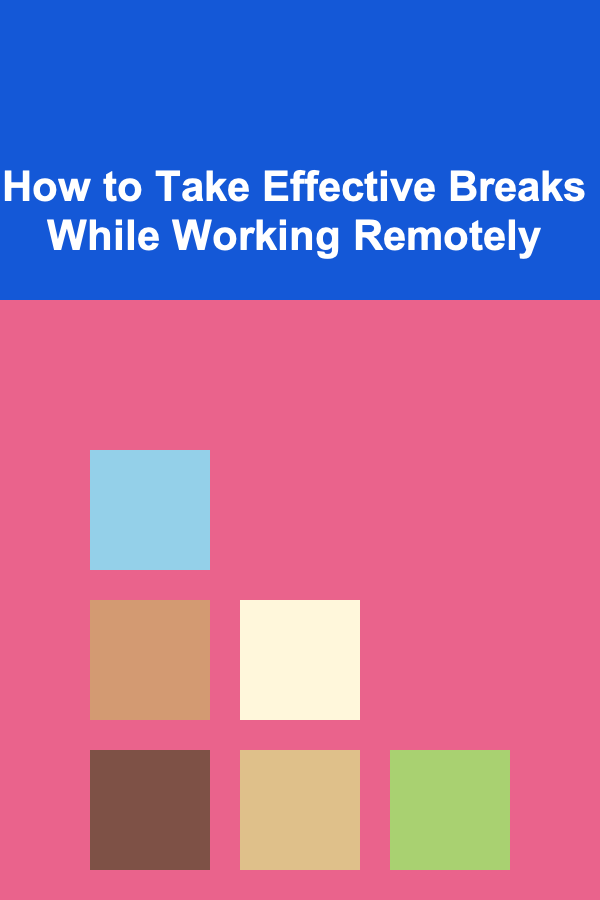
How to Take Effective Breaks While Working Remotely
ebook include PDF & Audio bundle (Micro Guide)
$12.99$7.99
Limited Time Offer! Order within the next:

Remote work has become increasingly prevalent over the past few years, transforming the traditional office setup. With the rise of flexible work schedules and the convenience of working from home, many have found themselves balancing professional tasks with the temptations and distractions of home life. While remote work offers numerous benefits, it also poses challenges in maintaining focus and productivity. One of the most crucial aspects of working remotely is knowing how to take effective breaks. Breaks, when done correctly, can significantly boost productivity, mental clarity, and overall well-being. This article will explore how to take effective breaks while working remotely, providing strategies, tips, and insights to help remote workers optimize their workday and maintain a healthy work-life balance.
The Importance of Breaks
Before diving into the specific strategies for taking breaks, it's important to understand why breaks are so critical, especially when working remotely.
1. Mental Refreshment
Taking breaks allows the brain to rest and recharge. Continuous work, especially when tasks require intense focus, can lead to mental fatigue. Breaks help to clear the mind, enabling you to approach tasks with a fresh perspective.
2. Enhanced Productivity
Studies have shown that working for long, uninterrupted stretches can lead to diminishing returns. Taking short breaks helps maintain consistent performance and prevents burnout. Regular breaks improve concentration, creativity, and problem-solving abilities.
3. Physical Well-being
Sitting for extended periods is one of the significant health risks associated with remote work. Taking regular breaks allows you to stretch, move around, and reduce the negative effects of a sedentary lifestyle, such as back pain, eye strain, and poor posture.
4. Mental Health Benefits
Remote work can sometimes feel isolating, leading to stress, anxiety, or even feelings of loneliness. Taking breaks offers an opportunity to step away from the work environment, check in with personal needs, and recharge mentally and emotionally.
The Types of Breaks to Take
Not all breaks are created equal. To ensure that your breaks are truly effective, it's important to understand the different types of breaks and when to incorporate each into your workday.
1. Micro-breaks
Micro-breaks are short, quick breaks that typically last between 1-5 minutes. These breaks involve brief activities such as standing up, stretching, or even changing your posture. Micro-breaks can be taken several times a day and are highly effective for maintaining focus and preventing fatigue.
Examples of Micro-Breaks:
- Stretching your arms, legs, and neck
- Getting up from your desk to walk around for a minute
- Taking a few deep breaths or practicing mindfulness
- Looking out the window to give your eyes a rest
2. Short Breaks
Short breaks generally last anywhere between 5-15 minutes and are ideal for a mental reset. These breaks are longer than micro-breaks and can involve activities that help you disconnect from work for a short period.
Examples of Short Breaks:
- Making a cup of tea or coffee
- Checking in with family members or friends
- Listening to music or a short podcast
- Going outside for a breath of fresh air
3. Long Breaks
Long breaks typically occur around lunchtime and last anywhere from 30 minutes to an hour. These breaks allow for a deeper disconnection from work and provide ample time for rest, nourishment, and recharging.
Examples of Long Breaks:
- Taking a walk or engaging in physical activity
- Preparing and eating a nutritious lunch
- Doing a quick household chore
- Watching a short TV episode or reading a book
4. Mental Breaks
Mental breaks are especially important in remote work, where distractions can come in many forms. These breaks are not about physical activity but about taking a mental step away from work to clear your mind and recharge emotionally.
Examples of Mental Breaks:
- Meditation or mindfulness exercises
- Practicing deep breathing exercises
- Doing a creative activity (e.g., drawing, writing, or knitting)
- Journaling your thoughts or reflections
How to Take Breaks Effectively
Now that we've established the importance of breaks and the various types of breaks, let's delve into how to take breaks effectively. Remote workers face unique challenges, including the blurred lines between work and personal life, so being intentional with your breaks is key.
1. Schedule Your Breaks
One of the biggest challenges of remote work is the temptation to work endlessly without breaks. Without the structure of an office environment, it's easy to fall into the trap of continuous work. To avoid this, schedule regular breaks throughout the day.
Tips for Scheduling Breaks:
- Use a time management technique, such as the Pomodoro Technique (25 minutes of work, followed by a 5-minute break) or a 90-minute work cycle with a 20-minute break.
- Set alarms or reminders on your phone or computer to signal when it's time for a break.
- Include breaks as part of your calendar or to-do list to ensure they are not overlooked.
2. Make Breaks Non-Negotiable
Treat your breaks as a non-negotiable part of your workday. Don't fall into the trap of thinking that skipping a break will help you get more done. It may seem productive in the moment, but it will only lead to burnout and reduced effectiveness over time. By committing to breaks, you prioritize your well-being and productivity.
3. Use Breaks for Physical Activity
Sitting for long periods can have negative consequences for both your body and mind. Incorporating physical movement into your breaks is an excellent way to counteract the sedentary nature of remote work. Regular physical activity not only reduces the risk of health issues but also improves cognitive function.
Ways to Add Physical Activity During Breaks:
- Do a few minutes of stretching or yoga.
- Take a quick walk around the house or outside.
- Dance to your favorite song.
- Try a short workout or a bodyweight exercise routine.
4. Disconnect from Technology
When taking breaks, try to disconnect from your screens entirely. Stepping away from your computer or phone helps your eyes recover from screen time and allows you to recharge mentally. If possible, spend time doing an activity that doesn't involve technology, such as reading a book, drawing, or enjoying nature.
5. Engage in Mindful Activities
Mindfulness and relaxation practices are powerful tools for enhancing break effectiveness. Taking time to relax your mind can help reduce stress, improve focus, and promote overall well-being.
Mindful Break Ideas:
- Practice deep breathing exercises or try progressive muscle relaxation.
- Meditate for a few minutes using a mindfulness app (e.g., Calm or Headspace).
- Try visualization techniques where you imagine yourself in a calming environment.
6. Step Outside and Get Fresh Air
One of the best ways to refresh your mind during a break is to step outside and get some fresh air. Sunlight and a change of scenery can help reset your mental state and provide a much-needed break from the confines of your home workspace.
Outdoor Break Ideas:
- Take a walk in your garden, on the balcony, or around the block.
- Sit outside and enjoy a cup of coffee or tea.
- Stand by an open window to enjoy fresh air and natural light.
7. Socialize During Breaks
Remote work can be isolating, so it's important to incorporate social interactions into your breaks. Whether it's chatting with a colleague or catching up with a friend or family member, socializing can boost your mood and make your break more enjoyable.
Social Break Ideas:
- Call or video chat with a colleague or friend.
- Share a virtual coffee break with teammates or family.
- Engage in a hobby or activity with others, like playing an online game or cooking together.
8. Keep Your Breaks Brief but Refreshing
Effective breaks don't need to be long to be beneficial. In fact, shorter breaks that are focused and intentional can often provide more of a mental reset than longer breaks that feel more like time off.
The Science of Breaks: Why They Work
Research shows that taking regular breaks enhances cognitive function, creativity, and productivity. Studies have also revealed that the brain operates in cycles, with periods of high focus followed by a need for rest. Working without breaks can result in decision fatigue, decreased focus, and burnout. Therefore, breaks not only prevent negative effects but also optimize performance.
The Ultradian Rhythm
Our bodies follow natural cycles called ultradian rhythms, which last about 90 minutes. During each cycle, our body moves through phases of high energy and focus followed by a natural dip. Taking breaks aligns with these rhythms, allowing us to work at our peak and rest during the dip.
Conclusion
Taking effective breaks is essential for maintaining productivity, mental clarity, and physical well-being while working remotely. By scheduling regular breaks, incorporating physical activity, disconnecting from technology, and engaging in mindful activities, remote workers can optimize their workday and reduce the risk of burnout. Breaks aren't just about taking time off; they are a critical component of a productive, balanced, and sustainable work routine.

Earning Passive Income through Deep Learning Automation
Read More
How to Create a Sports Equipment Inventory for Easy Management
Read More
How to Plan a Family Backyard Olympics with Fun Events
Read More
How to Set Up a Safe and Comfortable Pet Space in Your Home
Read More
How to Stage Your Home to Appeal to Downsizing Buyers
Read More
How to Understand the Principles of Value in Art
Read MoreOther Products

Earning Passive Income through Deep Learning Automation
Read More
How to Create a Sports Equipment Inventory for Easy Management
Read More
How to Plan a Family Backyard Olympics with Fun Events
Read More
How to Set Up a Safe and Comfortable Pet Space in Your Home
Read More
How to Stage Your Home to Appeal to Downsizing Buyers
Read More